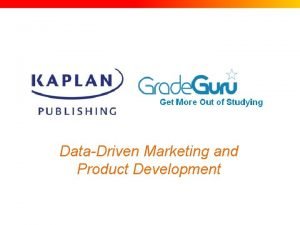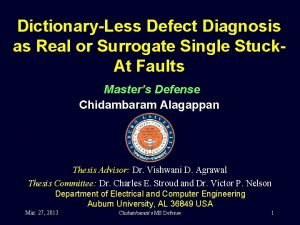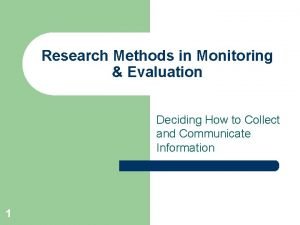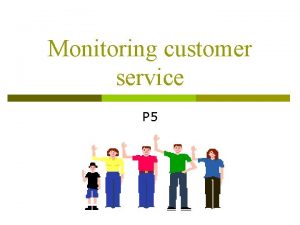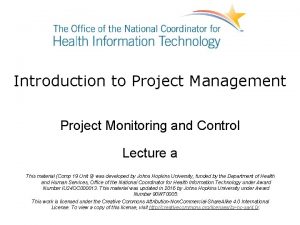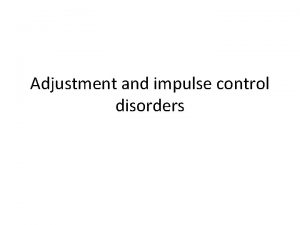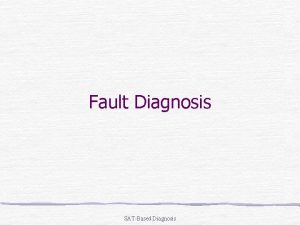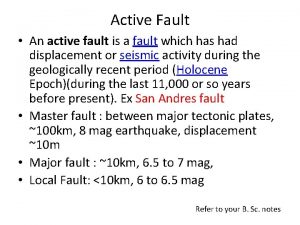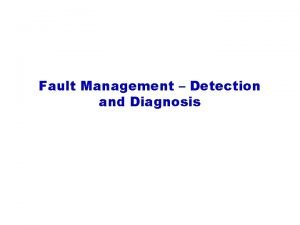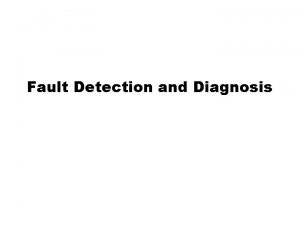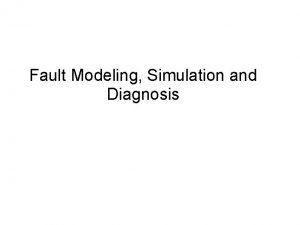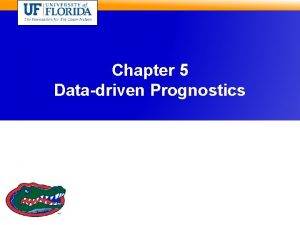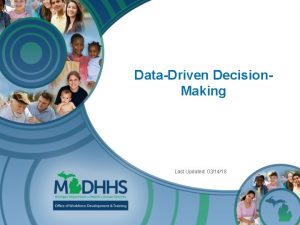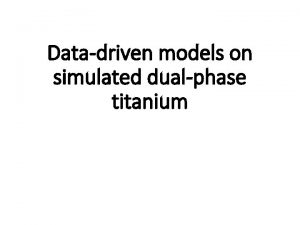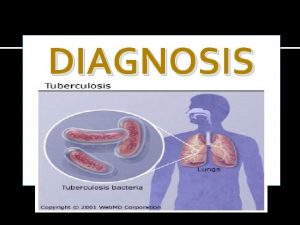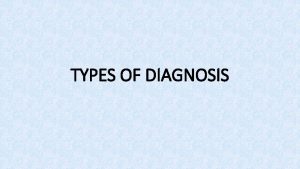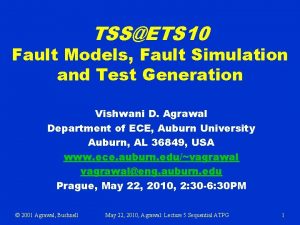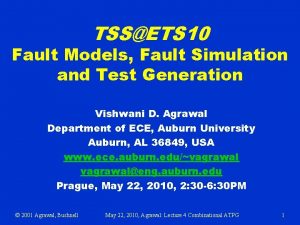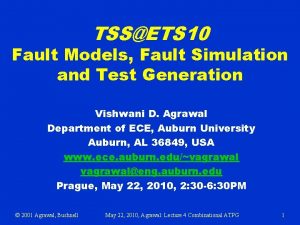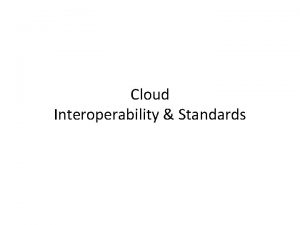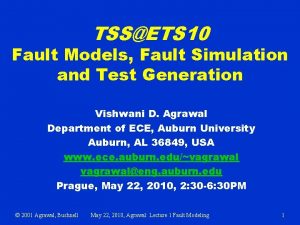Datadriven Methods for Monitoring Fault Diagnosis Control and






























- Slides: 30

Data-driven Methods for Monitoring, Fault Diagnosis, Control and Optimization John Mac. Gregor Pro. Sensus, Inc. Master University Ali Cinar Illinois Institute of Technology

Overview • An overall theme: Making use of historical plant data • Empirical models • Optimization • Control John Mac. Gregor • Monitoring and fault diagnosis • Fault tolerant control Ali Cinar

Models • Mechanistic – Structure from theory / Parameters from data – Advantages are well known – Problems: • Assumptions that may be poor; theory for many y’s not known • May not incorporate many of measured variables • Examples: Y’s or X’s that are images or PAT sensors • Empirical – Structure and parameters from data – Advantages are again well known: – Problems: • Structure is often imposed and unrealistic, no interpretability nor any causality

Latent Variable Models - Concepts Measured variables Latent variable space t 2 t 1 X T Summary statistics: T 2 and SPE (c) 2004 -2010, Pro. Sensus, Inc.

Latent variable regression models Two data matrices: X and Y X X = T PT + E T Y Y = T CT + F Symmetric in X and Y • No hypothesized relation between X and Y • Both X and Y are functions of the latent variables, T • Choice of what is X and Y depends upon objectives (c) 2004 -2010, Pro. Sensus, Inc.

Why Latent Variable Models? • Low dimensional models – Define the space containing most of the information • Simultaneously model both the X and Y spaces – Model structure truly determined by the data – This makes models unique and interpretable – Provides causal models in the low dimensional LV space • Allows for active use of the model (eg. optimization) – Allows for • easy handling of missing data • Easy detection of abnormal observations (*) • Other regression methods (MLR, ANN, etc) do not share these advantages when using historical data. – Non-unique, uninterpretable, non-causal

Optimization in Latent Variable Spaces • For active use of model, must have causality – Active use optimization / control / diagnosis • Historical plant data generally do not contain causal information on individual variables – Nor will any model built from these data • But latent variable models do provide causality in the low dimensional LV space (t 1, t 2, …) – Y = TCT X= TPT (t’s define Y and X) – T = XW* (To change T must move combinations of x’s) • Optimization in low dimensional LV space – Then X and Y obtained from LV’s • Illustrate concept with 2 industrial examples

Optimization: Injection molding process • GE water systems (2003) – Polyurethane film manufacture very sensitive to humidity, temperature and raw material variations – Operators periodically readjusted the process largely by trial and error • Inject ~50 parts; measure ~10 quality variables; make adjustments – Injection velocity profiles, timing sequences, etc. • Iterate until within specification – Provided a good set of data for LV modeling • Nonlinear PLS model – 20 raw material properties; 26 process variables; 10 quality variables • Models for both Y and Variance (Y)

Optimization: Injection molding process – Constraints: • Humidity , temp and raw material properties constrained to their currently measured values • SPE < ϵ; T 2 < T 299% These ensure validity of model – Applied only when multivariate control limits violated – Results: 5 Readjustment in one step Improved quality Reduced scrap Operational since 2004 3 39 3 38 6 7 35 34 0 t[2 ] • • 20 21 -5 25 2 6 30 28 2327 2 4 -1 0 29

Optimization of a batch polymerization Pilot plant data (Air Products & Chemicals) Z variables batches tim e End Properties (13) Recipe & Initial Conditions X Variable Trajectories • Very high dimensional optimization problem • Easily solved in low dimensional LV space Y

Optimization for new product quality • Constraints or desired values are specified for the 13 y’s • Minimize batch duration • Optimization done in the three dimensional LV space Multiple solutions for Z, X -all satisfying the y specifications, but with different batch times.

Supervisory MPC of Batch Processes • Objective: Control final product quality – Product quality only measured upon completion of batch – Control problem is thus one of 1. Predicting final quality from all the initial and evolving data 2. Making optimal mid-course corrections at several decision points during the batch (QP) 3. Different objectives at each decision point – PLS models have been shown to be ideal for modeling batch trajectory data and predicting final quality • • • Build from historical batch data Plus some DOE runs at the decision points Closed-loop identification used for subsequent implementations

Supervisory MPC of Batch Processes • Commercial systems in food industry > 100, 000 batches controlled > 99. 9% up-time > 50% reduction in std dev of all final quality attributes - 20 -40% increases in productivity with ABC • LV models also allow MSPC monitoring throughout the batch. • This helps make controller robust to faults – e. g. wireless temp sensor failure – default controllers. without ABC SP Final quality attribute

Summary (first part) • Latent variable models provide powerful ways to use historical operating data – Can make use of all measured variables – Provide unique, interpretable models for analysis – Provide causality in the LV space for optimization, control • Industrial examples used to illustrate this – Provide monitoring and diagnosis capabilities (next part)

Implementation and Automation of Process Supervision • Many variations of PCA: PCA, MBPCA, DPCA, … • Many techniques: PCA, PLS, Independent Component Analysis (ICA), … • The Irish potato famine - single kind of potato (Lumper) Diversity provides robustness • Develop a SPM, FD and control system that uses many alternate techniques – How to decide which technique works better for a given situation? Add a management layer – How to improve decision-making with experience? Use distributed AI

Adaptive, Decentralized Process Supervision Develop an agent-based monitoring, fault detection, diagnosis, and control system to: – Coordinate alternative techniques for reliable and accurate fault detection, diagnosis (FDD) and control – Improve performance via: o context-dependent performance assessment and decision-making o multi-level learning o adaptation

Distributed Artificial Intelligence • Implement with Agent-Based Systems (ABS) • Decision-making is decentralized and divided into hierarchical layers • Agents: – are autonomous software entities – observe their environment – act on their environment according to predefined rules/algorithms – may adapt by changing their rules/interpretation based on their environmental conditions at run time

MADCABS: Monitoring Analysis Diagnosis and Control with Agent-Based Systems • MADCABS is built using a hierarchical layout, with physical communication layer, process supervision layer and agent management layer Basic information flow: Collection of raw data from plant Preprocessing, monitoring, diagnosis, control Mapping control actions back to process Evaluation of technique and agent performance

Process Monitoring Ø Calculates the performances: Accumulated performances fault detection agents are summed to find • Statistical processof monitoring techniques used the total performance of the monitoring agent – Principal component analysis (PCA) Ø Builds new statistical models: – Dynamic PCA (DPCA) When all monitoring agents are performing badly or the process – Multi-block PCA (MB-PCA) operating mode changes. Monitoring Organizer Process

Fault Detection Ø signalsare based the consensus formed • Gives Fault out-of-control detection agents theon monitoring between agentsand MB-PCA statisticsfault for detection PCA, DPCA Ø Observes performances fault detection agents under – Hotelling’s T 2 and SPEofstatistics detection agents different fault magnitudes and keeps Fault history 1. PCA_SPE Ø Triggers diagnosis agent 2 Fault detection organizer 2. 3. 4. 5. 6. Process PCA_T MB-PCA_SPE MB-PCA_T 2 DPCA_SPE DPCA_T 2

Fault Diagnosis Manager Consensus Fault Decision Fault Detection Organizer Diagnosis Training Agent Diagnosis Agent Fault Identification Agents Process Database

Fault Diagnosis: Identification techniques • Contribution Plots SPE – Variable contributions to monitoring statistics T 2 and SPE • Fishers Discriminant Analysis (FDA) • Partial Least Squares Discriminant Analysis (PLSDA) SPE = ee. T Fault Type 1 Fault Type 2 X Y Observation For an out-of-control observation: 1 s Error SPE = ∑e , Fault. Prediction Type 1 Squared Variance between classes j max j = 1, …, number of variables N Variance within classes Fault Type 2 1 s Variable Contributions Classifynew newobservation Classify basedon onthe theclass closeness to the based existing clusters membership X 1 y =X 3 BPLS x X 5

Fault Diagnosis (Identification) Agents Project the new fault data on the model and determine the most likely fault class PCA_SPE PCA_T 2 MB-PCA_SPE MBPCA_T 2 DPCA_SPE DPCA_T 2 [X 1, X 4, X 7] [X 1, X 4] [X 1, X 4, X 7, X 8] [X 1, X 4, X 6] [X 1, X 4] Contribution Map FDA PLSDA Estimator Identification (Discrimination) Agents Process Fault Signature for F 1 [X 1, X 4] Contribution Maps [X 1, X 4] : [F 1, …]

Agent Performance Management Layer Performance Evaluation: • Record the performance of the agent and the state metrics that define the state of the system when that performance is observed. [State Metrici, i=1, …, I ] = f (performance) • Compare the current state of the system to recorded states, and estimate the performance of the agent for the current state based on its performance for similar states in history.

Performance History Space Agent A State Metric 2 Pest, A Agent B Agent C For each agent: - Identify performances at closest state points. - Obtain a performance estimate for the current state point by interpolation. New Data Point: What would the performances of each agent be for this state? Pest, C State Metric 1 Pestimate d 1 P 2 d 3 d 2 P 3 Pest, B

Diagnosis Performance History • Record: – Fault signature • Fault signatures are the process variables significantly contributing to the inflation of the monitoring statistic • Fault signatures are available once the fault is detected – Performance of the agent for that fault signature • Performance is recorded only after diagnosis is confirmed • Use the history to find: – Agents that are the best performers for the current fault signature. Diagnosis agent uses the estimated performances of fault identification agents for the potential fault to form the consensus diagnosis decision

Adaptation: Performance-Based Consensus Analysis - Agents update their built-in knowledge and methods they use - Discriminant agents update their models with current data Adaptive FDA Adaptive PLSDA Contribution Map Estimator Over time, after a diagnosis decision is confirmed for a fault type, the misclassifications are used to update the models of the adaptive instances

Plant or simulator Fault-tolerant Control Structures System Identification MPC Control Single centralized control system PID control Set of Controllers Controller Performance Assessment Monitoring and Diagnosis Decentralized control: . Local coordinated MPCs. Local MPCs integrated with local FDD modules using ABS

Summary/Conclusions • Latent variable models provide powerful ways to use historical operating data • Data-driven methods are well-suited for distributed process supervision • Learning and adaptation in monitoring, FDD and control enable fault- tolerant control • MADCABS provides an environment for adaptive fault diagnosis and fault-tolerant control • There alternative approaches – Vive la difference!

Acknowledgements • IIT & ANL: • • • Fouad Teymour Cindy Hood Michael North Arsun Artel Inanc Birol David Mendoza Sinem Perk Quan. Min Shao Derya Tetiker Eric Tatara Cenk Undey Financial Support by National Science Foundation CTS-0325378 of the ITR program. • Mc. Master University & Pro. Sensus • • Many of my former grad students at Mc. Master The Pro. Sensus team
 Datadriven marketing
Datadriven marketing Single fault defect diagnosis
Single fault defect diagnosis The nursing process
The nursing process Medical diagnosis and nursing diagnosis difference
Medical diagnosis and nursing diagnosis difference Medical diagnosis and nursing diagnosis difference
Medical diagnosis and nursing diagnosis difference Nursing process and critical thinking
Nursing process and critical thinking Perbedaan diagnosis gizi dan diagnosis medis
Perbedaan diagnosis gizi dan diagnosis medis Research methods in monitoring and evaluation
Research methods in monitoring and evaluation Methods of monitoring customer service
Methods of monitoring customer service Direct and indirect wax pattern
Direct and indirect wax pattern Project monitoring and control
Project monitoring and control Methods of portion control in bread and pastry
Methods of portion control in bread and pastry Impulse control diagnosis
Impulse control diagnosis Fspos
Fspos Typiska novell drag
Typiska novell drag Nationell inriktning för artificiell intelligens
Nationell inriktning för artificiell intelligens Returpilarna
Returpilarna Varför kallas perioden 1918-1939 för mellankrigstiden
Varför kallas perioden 1918-1939 för mellankrigstiden En lathund för arbete med kontinuitetshantering
En lathund för arbete med kontinuitetshantering Kassaregister ideell förening
Kassaregister ideell förening Tidbok för yrkesförare
Tidbok för yrkesförare A gastrica
A gastrica Densitet vatten
Densitet vatten Datorkunskap för nybörjare
Datorkunskap för nybörjare Boverket ka
Boverket ka Hur skriver man en tes
Hur skriver man en tes Magnetsjukhus
Magnetsjukhus Nyckelkompetenser för livslångt lärande
Nyckelkompetenser för livslångt lärande Påbyggnader för flakfordon
Påbyggnader för flakfordon Lufttryck formel
Lufttryck formel Offentlig förvaltning
Offentlig förvaltning
